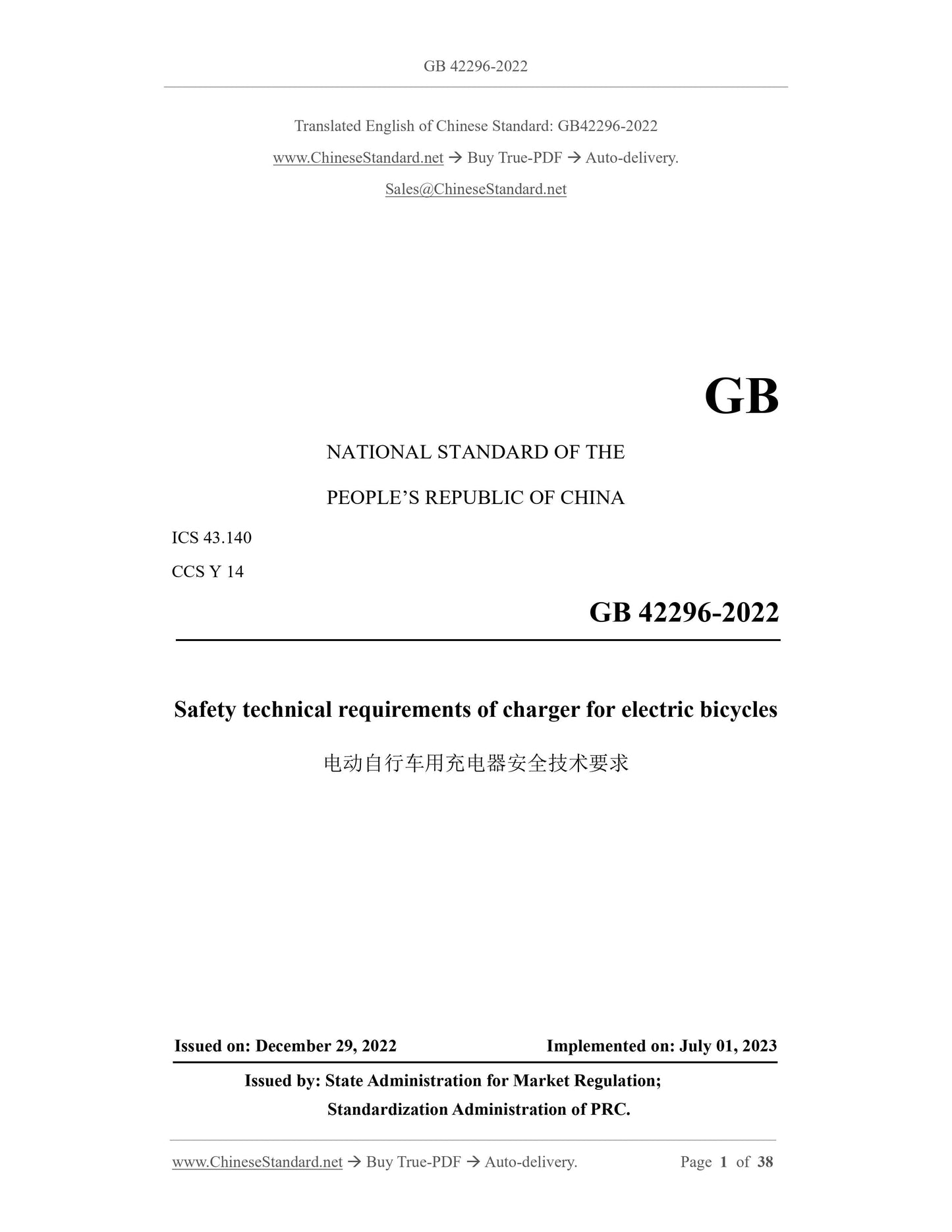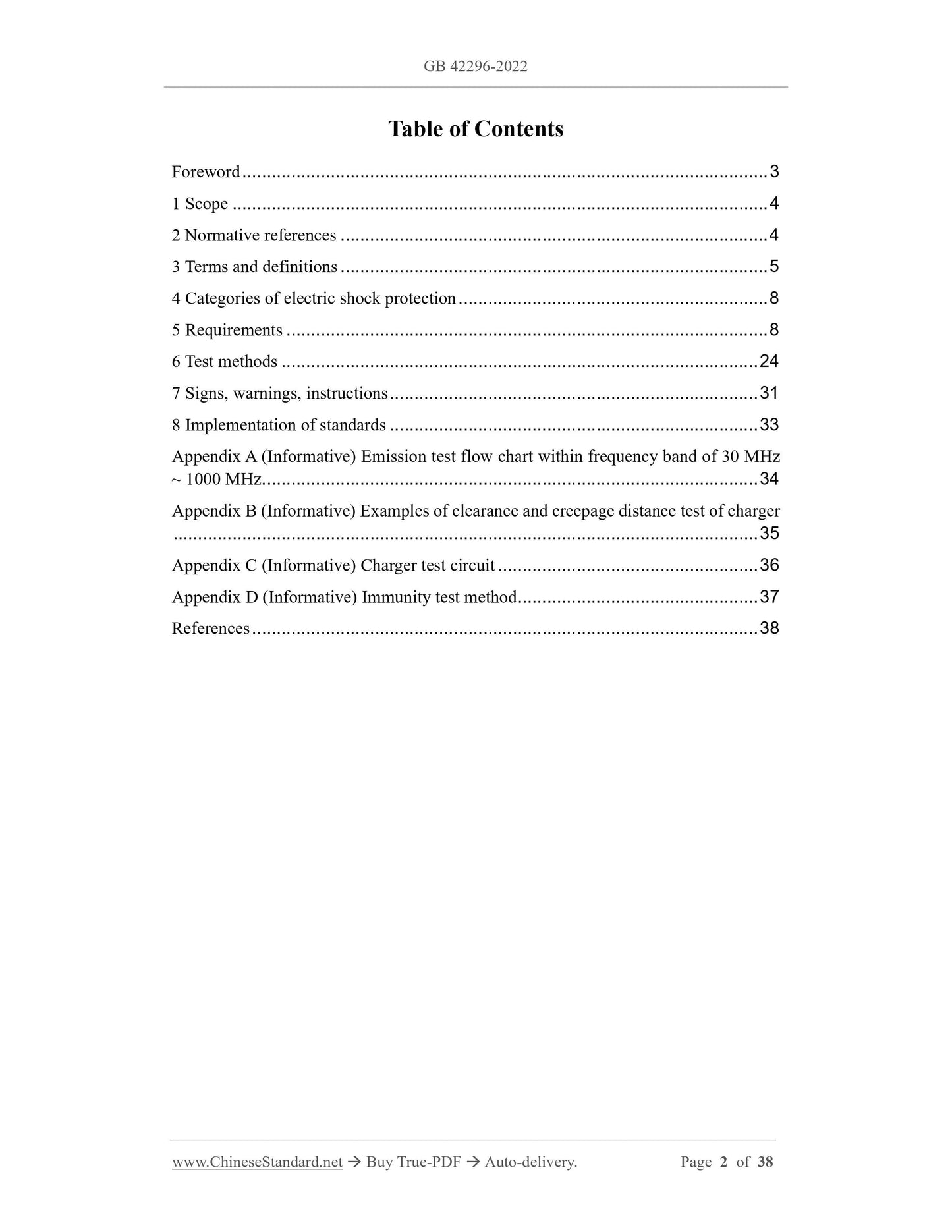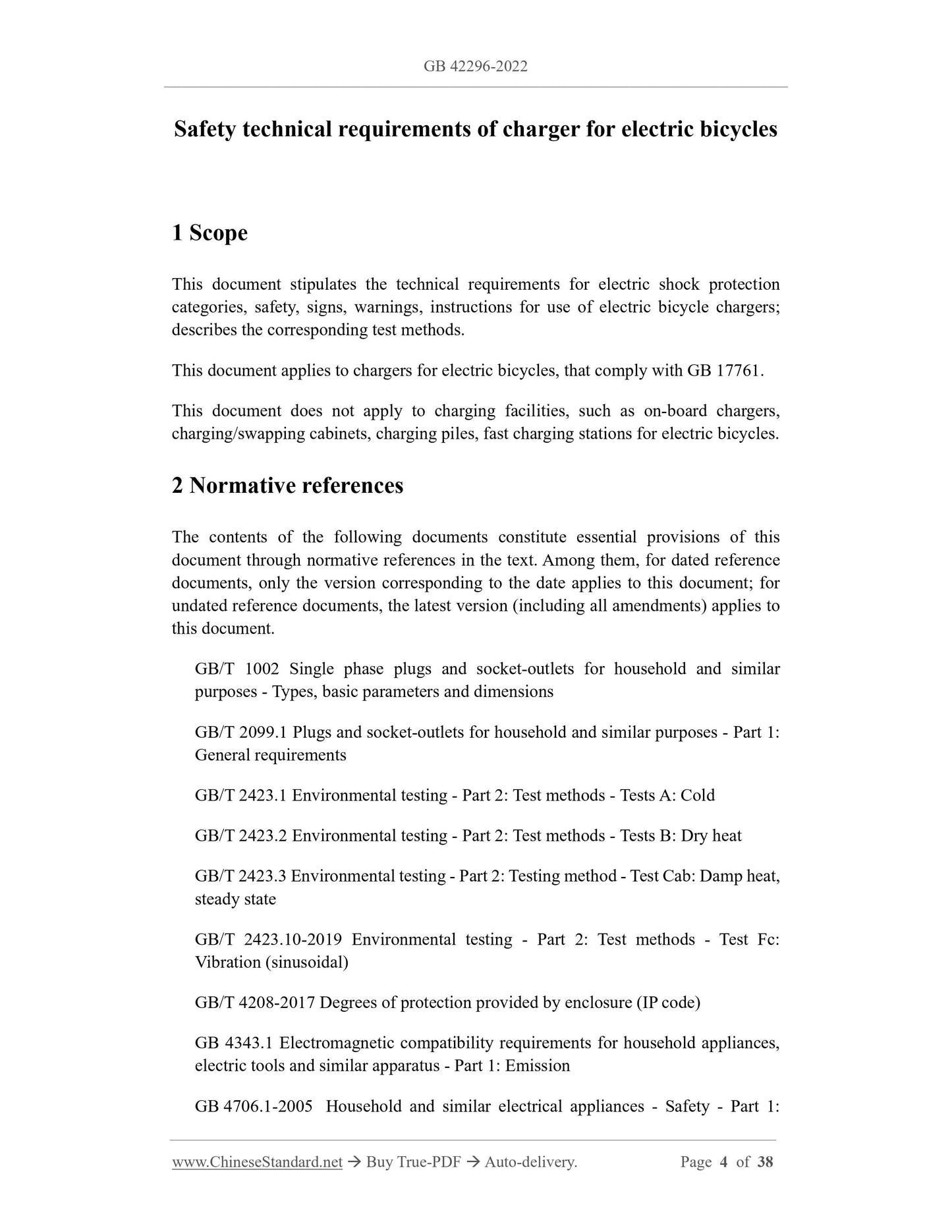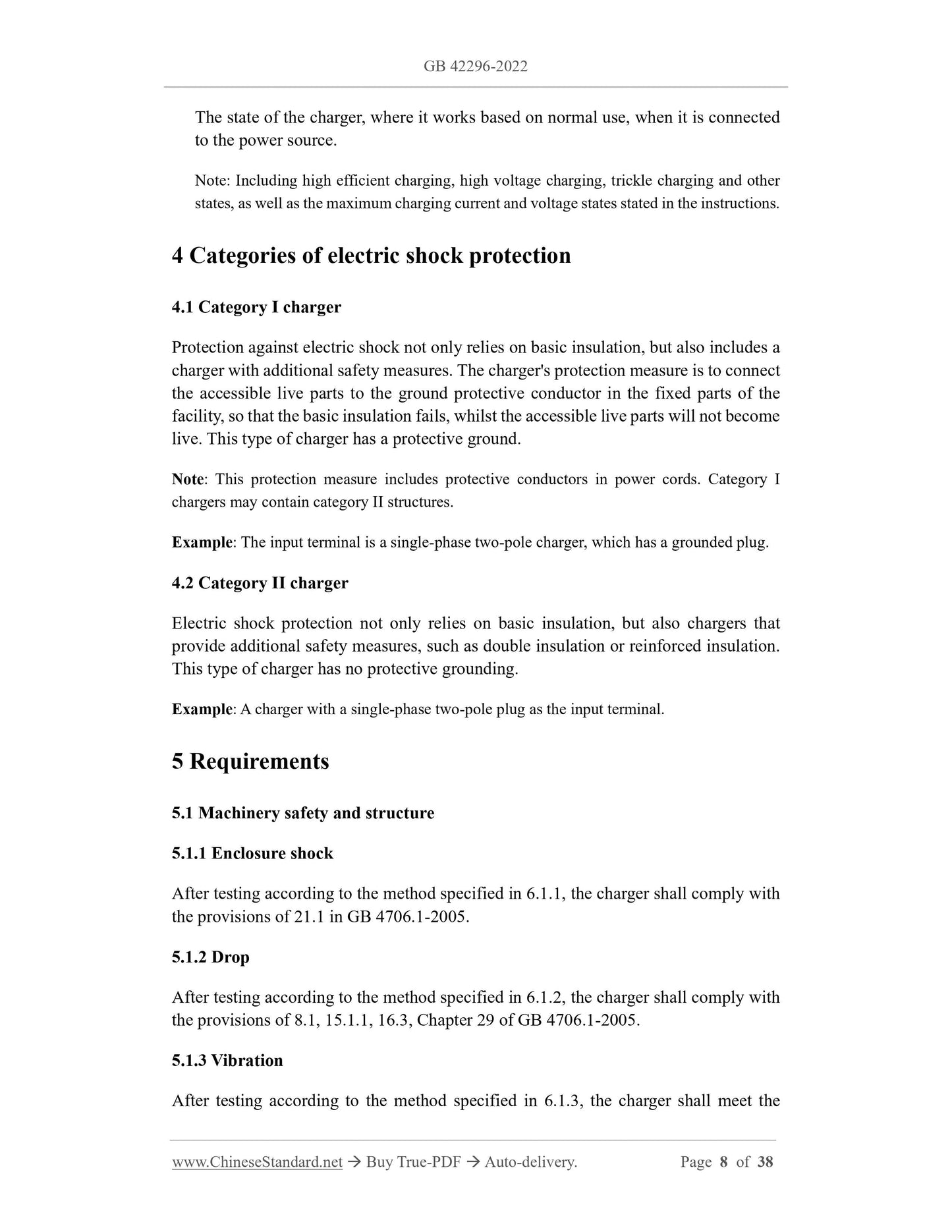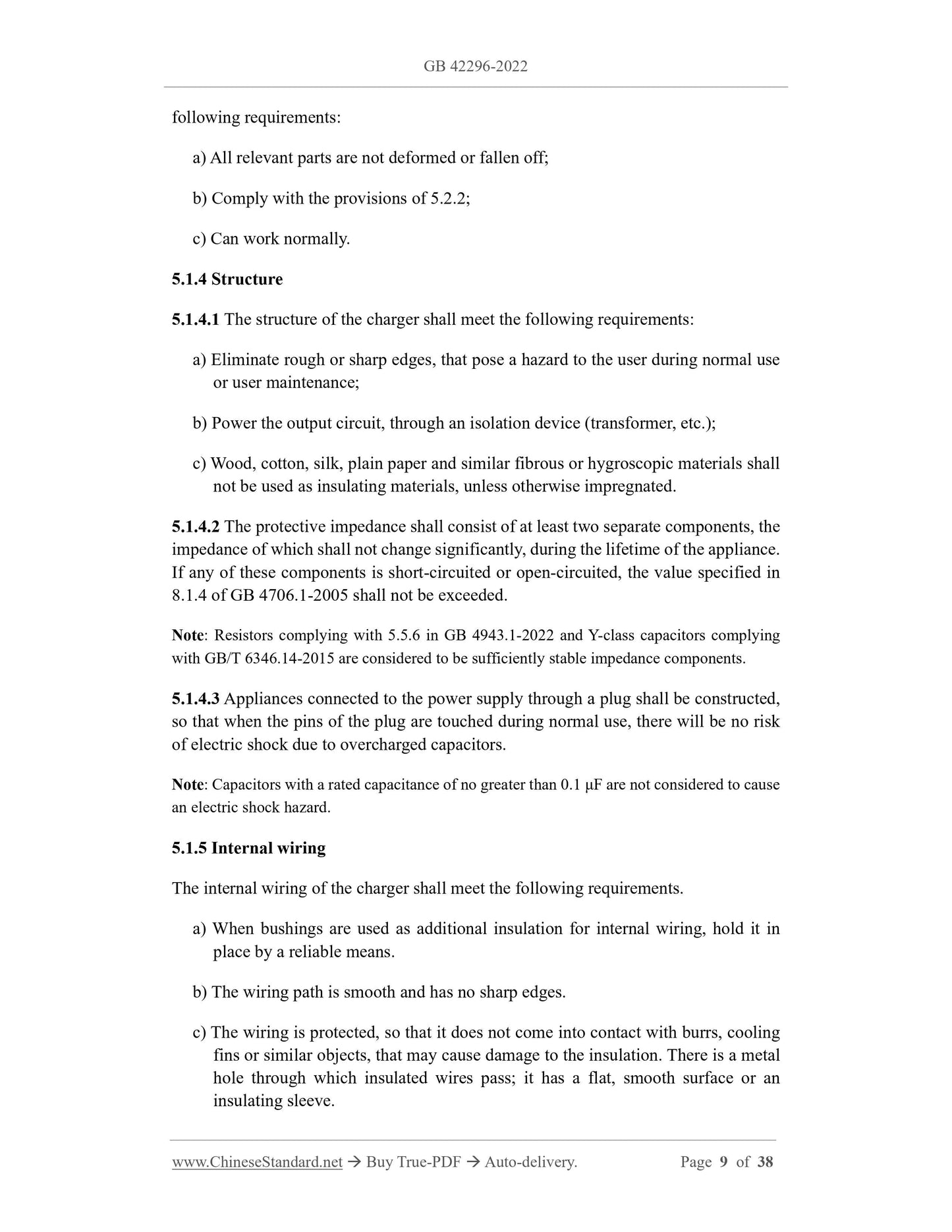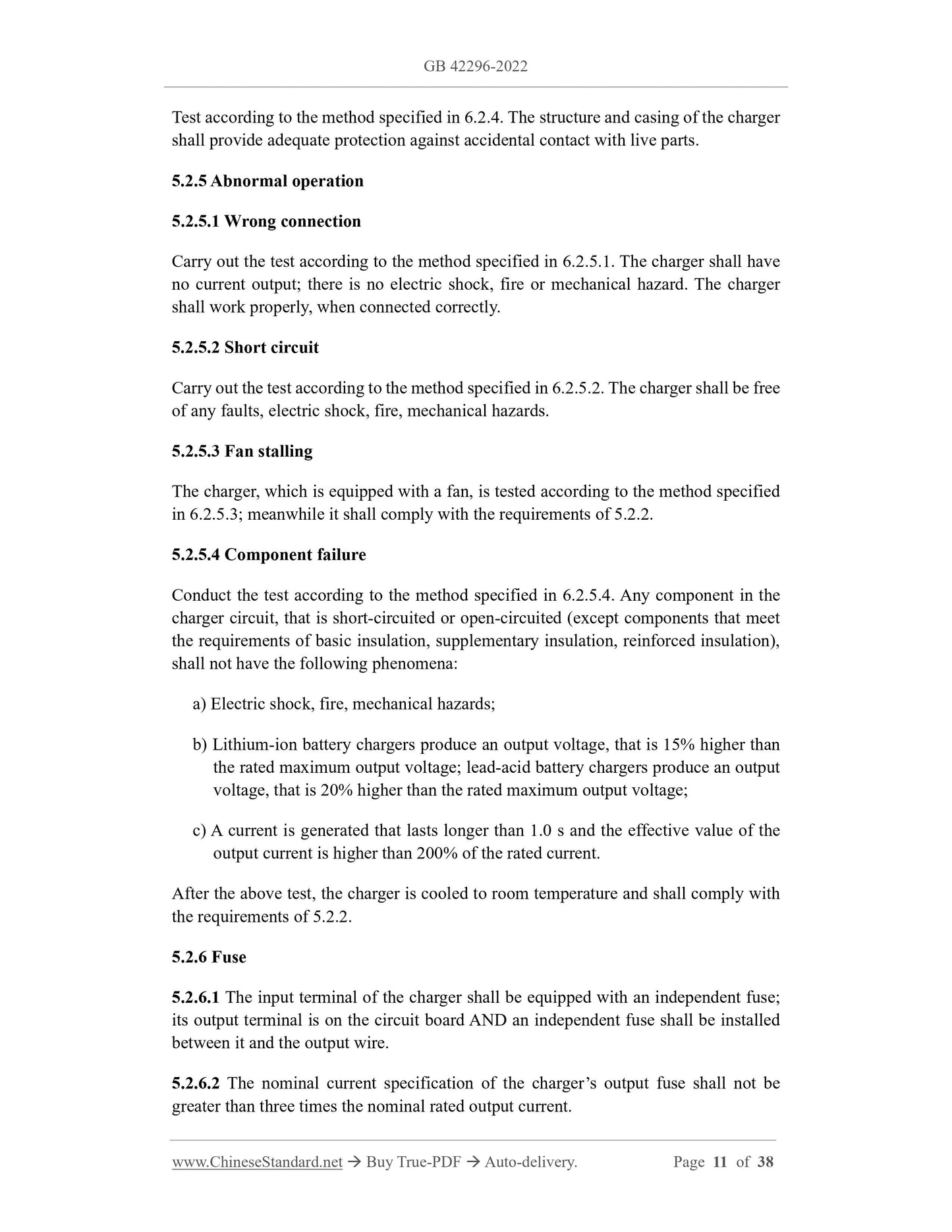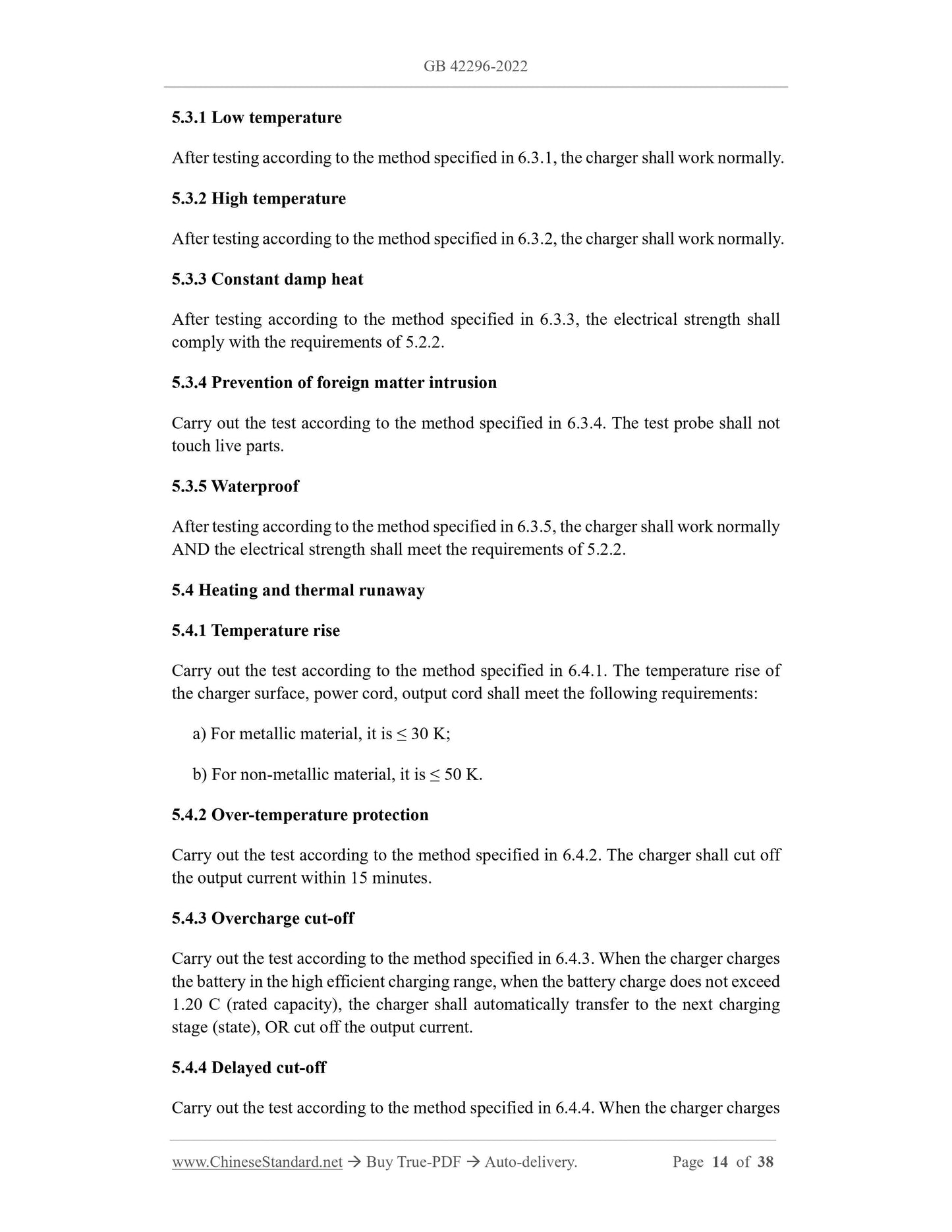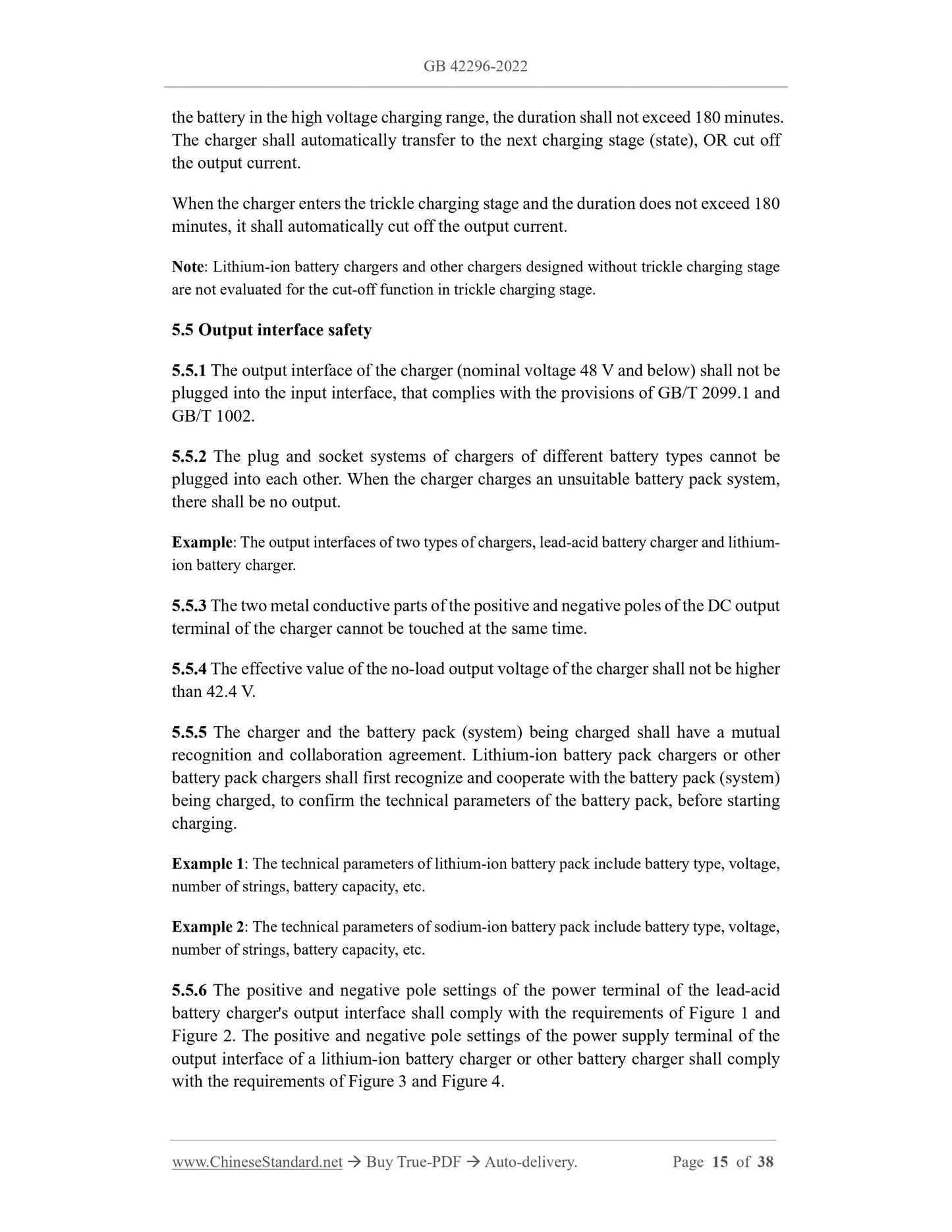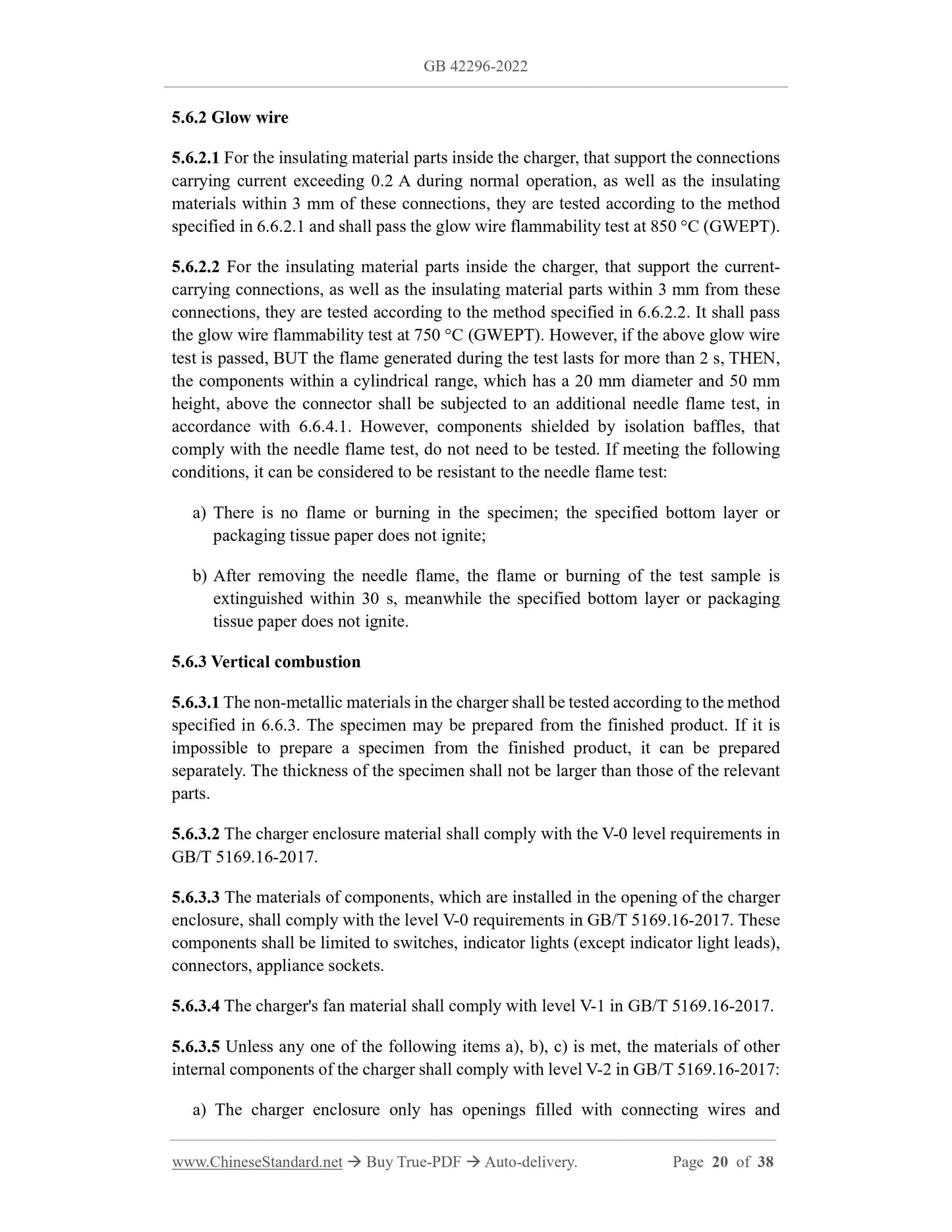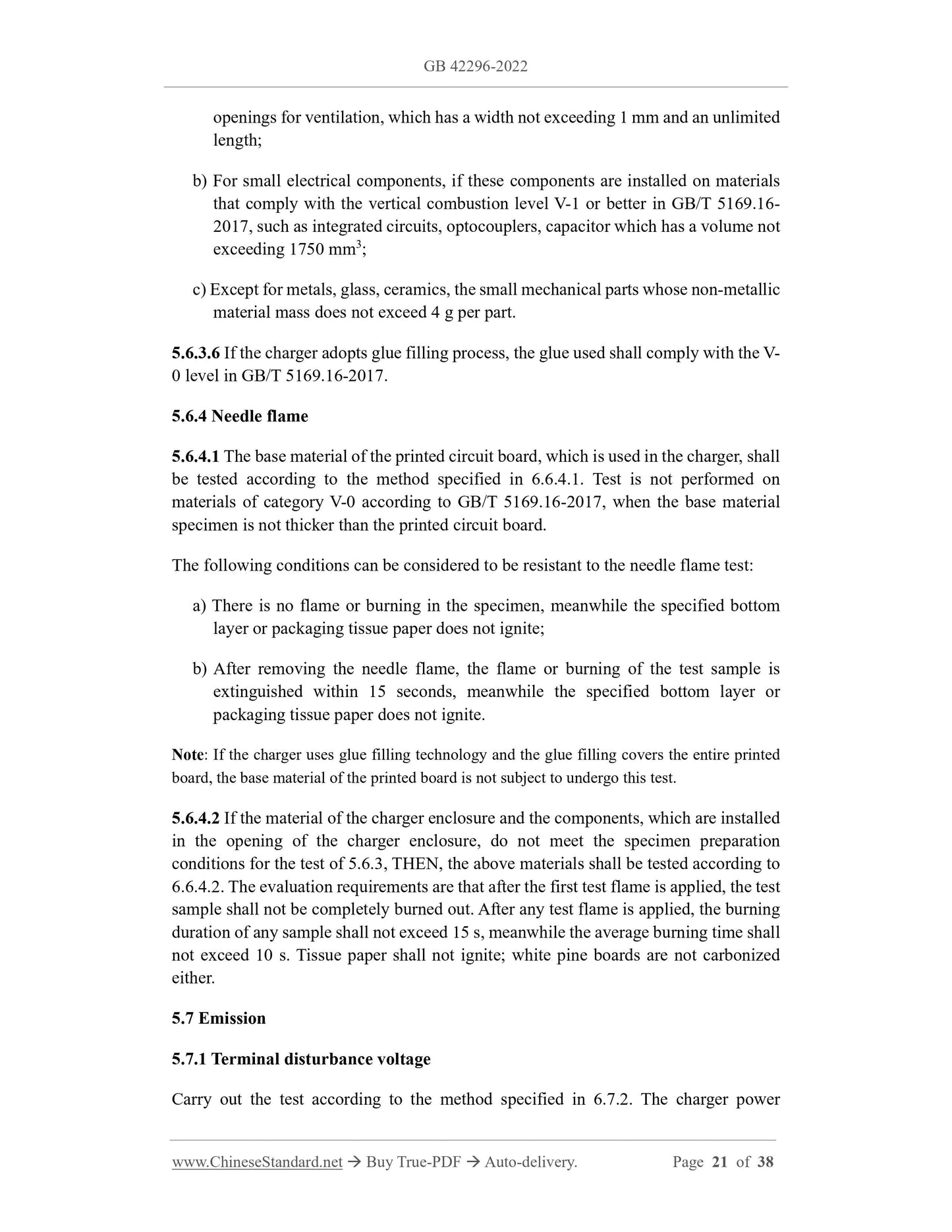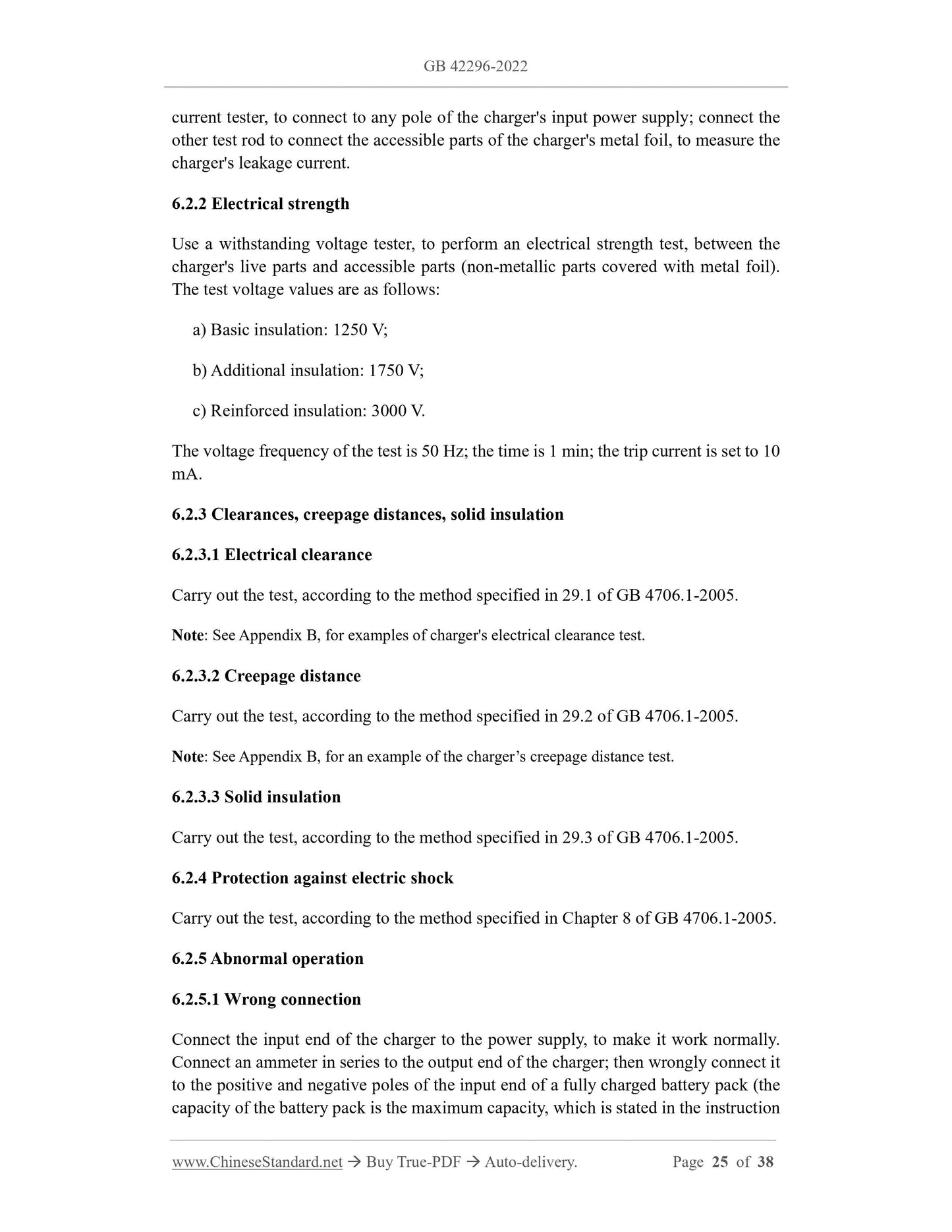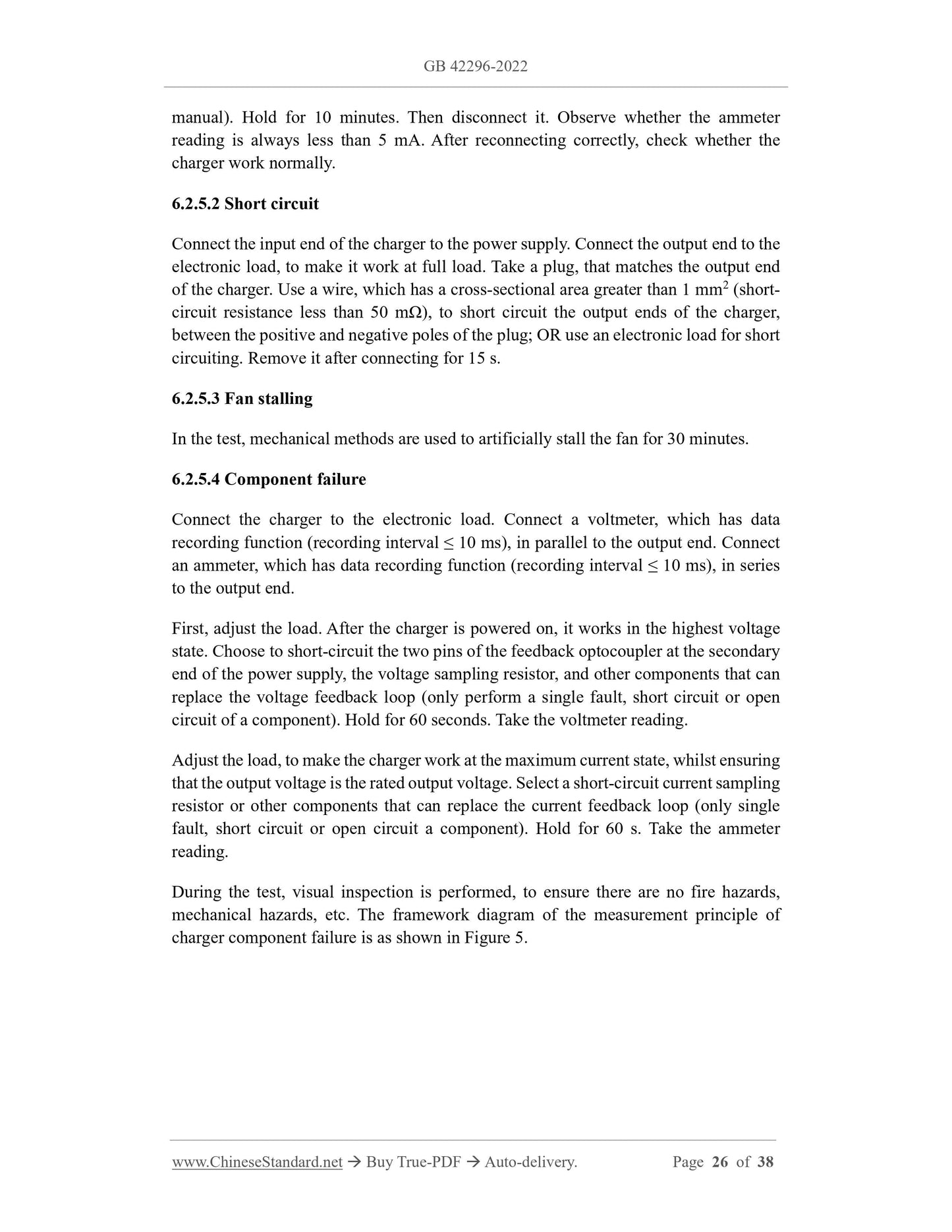1
/
of
12
PayPal, credit cards. Download editable-PDF and invoice in 1 second!
GB 42296-2022 English PDF
GB 42296-2022 English PDF
Regular price
$440.00 USD
Regular price
Sale price
$440.00 USD
Unit price
/
per
Shipping calculated at checkout.
Couldn't load pickup availability
Delivery: 3 seconds. Download true-PDF + Invoice.
Get QUOTATION in 1-minute: Click GB 42296-2022
Historical versions: GB 42296-2022
Preview True-PDF (Reload/Scroll if blank)
GB 42296-2022: [Including 2024XG1] Safety technical requirements of charger for electric bicycles
GB 42296-2022
GB
NATIONAL STANDARD OF THE
PEOPLE’S REPUBLIC OF CHINA
ICS 43.140
CCS Y 14
Safety technical requirements of charger for electric bicycles
ISSUED ON: DECEMBER 29, 2022
IMPLEMENTED ON: JULY 01, 2023
Issued by: State Administration for Market Regulation;
Standardization Administration of PRC.
Table of Contents
Foreword ... 3
1 Scope ... 4
2 Normative references ... 4
3 Terms and definitions ... 5
4 Categories of electric shock protection ... 8
5 Requirements ... 8
6 Test methods ... 24
7 Signs, warnings, instructions ... 31
8 Implementation of standards ... 33
Appendix A (Informative) Emission test flow chart within frequency band of 30 MHz
~ 1000 MHz ... 34
Appendix B (Informative) Examples of clearance and creepage distance test of charger
... 35
Appendix C (Informative) Charger test circuit ... 36
Appendix D (Informative) Immunity test method ... 37
References ... 38
Safety technical requirements of charger for electric bicycles
1 Scope
This document stipulates the technical requirements for electric shock protection
categories, safety, signs, warnings, instructions for use of electric bicycle chargers;
describes the corresponding test methods.
This document applies to chargers for electric bicycles, that comply with GB 17761.
This document does not apply to charging facilities, such as on-board chargers,
charging/swapping cabinets, charging piles, fast charging stations for electric bicycles.
2 Normative references
The contents of the following documents constitute essential provisions of this
document through normative references in the text. Among them, for dated reference
documents, only the version corresponding to the date applies to this document; for
undated reference documents, the latest version (including all amendments) applies to
this document.
GB/T 1002 Single phase plugs and socket-outlets for household and similar
purposes - Types, basic parameters and dimensions
GB/T 2099.1 Plugs and socket-outlets for household and similar purposes - Part 1:
General requirements
GB/T 2423.1 Environmental testing - Part 2: Test methods - Tests A: Cold
GB/T 2423.2 Environmental testing - Part 2: Test methods - Tests B: Dry heat
GB/T 2423.3 Environmental testing - Part 2: Testing method - Test Cab: Damp heat,
steady state
GB/T 2423.10-2019 Environmental testing - Part 2: Test methods - Test Fc:
Vibration (sinusoidal)
GB/T 4208-2017 Degrees of protection provided by enclosure (IP code)
GB 4343.1 Electromagnetic compatibility requirements for household appliances,
electric tools and similar apparatus - Part 1: Emission
GB 4706.1-2005 Household and similar electrical appliances - Safety - Part 1:
The state of the charger, where it works based on normal use, when it is connected
to the power source.
Note: Including high efficient charging, high voltage charging, trickle charging and other
states, as well as the maximum charging current and voltage states stated in the instructions.
4 Categories of electric shock protection
4.1 Category I charger
Protection against electric shock not only relies on basic insulation, but also includes a
charger with additional safety measures. The charger's protection measure is to connect
the accessible live parts to the ground protective conductor in the fixed parts of the
facility, so that the basic insulation fails, whilst the accessible live parts will not become
live. This type of charger has a protective ground.
Note: This protection measure includes protective conductors in power cords. Category I
chargers may contain category II structures.
Example: The input terminal is a single-phase two-pole charger, which has a grounded plug.
4.2 Category II charger
Electric shock protection not only relies on basic insulation, but also chargers that
provide additional safety measures, such as double insulation or reinforced insulation.
This type of charger has no protective grounding.
Example: A charger with a single-phase two-pole plug as the input terminal.
5 Requirements
5.1 Machinery safety and structure
5.1.1 Enclosure shock
After testing according to the method specified in 6.1.1, the charger shall comply with
the provisions of 21.1 in GB 4706.1-2005.
5.1.2 Drop
After testing according to the method specified in 6.1.2, the charger shall comply with
the provisions of 8.1, 15.1.1, 16.3, Chapter 29 of GB 4706.1-2005.
5.1.3 Vibration
After testing according to the method specified in 6.1.3, the charger shall meet the
following requirements:
a) All relevant parts are not deformed or fallen off;
b) Comply with the provisions of 5.2.2;
c) Can work normally.
5.1.4 Structure
5.1.4.1 The structure of the charger shall meet the following requirements:
a) Eliminate rough or sharp edges, that pose a hazard to the user during normal use
or user maintenance;
b) Power the output circuit, through an isolation device (transformer, etc.);
c) Wood, cotton, silk, plain paper and similar fibrous or hygroscopic materials shall
not be used as insulating materials, unless otherwise impregnated.
5.1.4.2 The protective impedance shall consist of at least two separate components, the
impedance of which shall not change significantly, during the lifetime of the appliance.
If any of these components is short-circuited or open-circuited, the value specified in
8.1.4 of GB 4706.1-2005 shall not be exceeded.
Note: Resistors complying with 5.5.6 in GB 4943.1-2022 and Y-class capacitors complying
with GB/T 6346.14-2015 are considered to be sufficiently stable impedance components.
5.1.4.3 Appliances connected to the power supply through a plug shall be constructed,
so that when the pins of the plug are touched during normal use, there will be no risk
of electric shock due to overcharged capacitors.
Note: Capacitors with a rated capacitance of no greater than 0.1 μF are not considered to cause
an electric shock hazard.
5.1.5 Internal wiring
The internal wiring of the charger shall meet the following requirements.
a) When bushings are used as additional insulation for internal wiring, hold it in
place by a reliable means.
b) The wiring path is smooth and has no sharp edges.
c) The wiring is protected, so that it does not come into contact with burrs, cooling
fins or similar objects, that may cause damage to the insulation. There is a metal
hole through which insulated wires pass; it has a flat, smooth surface or an
insulating sleeve.
Test according to the method specified in 6.2.4. The structure and casing of the charger
shall provide adequate protection against accidental contact with live parts.
5.2.5 Abnormal operation
5.2.5.1 Wrong connection
Carry out the test according to the method specified in 6.2.5.1. The charger shall have
no current output; there is no electric shock, fire or mechanical hazard. The charger
shall work properly, when connected correctly.
5.2.5.2 Short circuit
Carry out the test according to the method specified in 6.2.5.2. The charger shall be free
of any faults, electric shock, fire, mechanical hazards.
5.2.5.3 Fan stalling
The charger, which is equipped with a fan, is tested according to the method specified
in 6.2.5.3; meanwhile it shall comply with the requirements of 5.2.2.
5.2.5.4 Component failure
Conduct the test according to the method specified in 6.2.5.4. Any component in the
charger circuit, that is short-circuited or open-circuited (except components that meet <...
Get QUOTATION in 1-minute: Click GB 42296-2022
Historical versions: GB 42296-2022
Preview True-PDF (Reload/Scroll if blank)
GB 42296-2022: [Including 2024XG1] Safety technical requirements of charger for electric bicycles
GB 42296-2022
GB
NATIONAL STANDARD OF THE
PEOPLE’S REPUBLIC OF CHINA
ICS 43.140
CCS Y 14
Safety technical requirements of charger for electric bicycles
ISSUED ON: DECEMBER 29, 2022
IMPLEMENTED ON: JULY 01, 2023
Issued by: State Administration for Market Regulation;
Standardization Administration of PRC.
Table of Contents
Foreword ... 3
1 Scope ... 4
2 Normative references ... 4
3 Terms and definitions ... 5
4 Categories of electric shock protection ... 8
5 Requirements ... 8
6 Test methods ... 24
7 Signs, warnings, instructions ... 31
8 Implementation of standards ... 33
Appendix A (Informative) Emission test flow chart within frequency band of 30 MHz
~ 1000 MHz ... 34
Appendix B (Informative) Examples of clearance and creepage distance test of charger
... 35
Appendix C (Informative) Charger test circuit ... 36
Appendix D (Informative) Immunity test method ... 37
References ... 38
Safety technical requirements of charger for electric bicycles
1 Scope
This document stipulates the technical requirements for electric shock protection
categories, safety, signs, warnings, instructions for use of electric bicycle chargers;
describes the corresponding test methods.
This document applies to chargers for electric bicycles, that comply with GB 17761.
This document does not apply to charging facilities, such as on-board chargers,
charging/swapping cabinets, charging piles, fast charging stations for electric bicycles.
2 Normative references
The contents of the following documents constitute essential provisions of this
document through normative references in the text. Among them, for dated reference
documents, only the version corresponding to the date applies to this document; for
undated reference documents, the latest version (including all amendments) applies to
this document.
GB/T 1002 Single phase plugs and socket-outlets for household and similar
purposes - Types, basic parameters and dimensions
GB/T 2099.1 Plugs and socket-outlets for household and similar purposes - Part 1:
General requirements
GB/T 2423.1 Environmental testing - Part 2: Test methods - Tests A: Cold
GB/T 2423.2 Environmental testing - Part 2: Test methods - Tests B: Dry heat
GB/T 2423.3 Environmental testing - Part 2: Testing method - Test Cab: Damp heat,
steady state
GB/T 2423.10-2019 Environmental testing - Part 2: Test methods - Test Fc:
Vibration (sinusoidal)
GB/T 4208-2017 Degrees of protection provided by enclosure (IP code)
GB 4343.1 Electromagnetic compatibility requirements for household appliances,
electric tools and similar apparatus - Part 1: Emission
GB 4706.1-2005 Household and similar electrical appliances - Safety - Part 1:
The state of the charger, where it works based on normal use, when it is connected
to the power source.
Note: Including high efficient charging, high voltage charging, trickle charging and other
states, as well as the maximum charging current and voltage states stated in the instructions.
4 Categories of electric shock protection
4.1 Category I charger
Protection against electric shock not only relies on basic insulation, but also includes a
charger with additional safety measures. The charger's protection measure is to connect
the accessible live parts to the ground protective conductor in the fixed parts of the
facility, so that the basic insulation fails, whilst the accessible live parts will not become
live. This type of charger has a protective ground.
Note: This protection measure includes protective conductors in power cords. Category I
chargers may contain category II structures.
Example: The input terminal is a single-phase two-pole charger, which has a grounded plug.
4.2 Category II charger
Electric shock protection not only relies on basic insulation, but also chargers that
provide additional safety measures, such as double insulation or reinforced insulation.
This type of charger has no protective grounding.
Example: A charger with a single-phase two-pole plug as the input terminal.
5 Requirements
5.1 Machinery safety and structure
5.1.1 Enclosure shock
After testing according to the method specified in 6.1.1, the charger shall comply with
the provisions of 21.1 in GB 4706.1-2005.
5.1.2 Drop
After testing according to the method specified in 6.1.2, the charger shall comply with
the provisions of 8.1, 15.1.1, 16.3, Chapter 29 of GB 4706.1-2005.
5.1.3 Vibration
After testing according to the method specified in 6.1.3, the charger shall meet the
following requirements:
a) All relevant parts are not deformed or fallen off;
b) Comply with the provisions of 5.2.2;
c) Can work normally.
5.1.4 Structure
5.1.4.1 The structure of the charger shall meet the following requirements:
a) Eliminate rough or sharp edges, that pose a hazard to the user during normal use
or user maintenance;
b) Power the output circuit, through an isolation device (transformer, etc.);
c) Wood, cotton, silk, plain paper and similar fibrous or hygroscopic materials shall
not be used as insulating materials, unless otherwise impregnated.
5.1.4.2 The protective impedance shall consist of at least two separate components, the
impedance of which shall not change significantly, during the lifetime of the appliance.
If any of these components is short-circuited or open-circuited, the value specified in
8.1.4 of GB 4706.1-2005 shall not be exceeded.
Note: Resistors complying with 5.5.6 in GB 4943.1-2022 and Y-class capacitors complying
with GB/T 6346.14-2015 are considered to be sufficiently stable impedance components.
5.1.4.3 Appliances connected to the power supply through a plug shall be constructed,
so that when the pins of the plug are touched during normal use, there will be no risk
of electric shock due to overcharged capacitors.
Note: Capacitors with a rated capacitance of no greater than 0.1 μF are not considered to cause
an electric shock hazard.
5.1.5 Internal wiring
The internal wiring of the charger shall meet the following requirements.
a) When bushings are used as additional insulation for internal wiring, hold it in
place by a reliable means.
b) The wiring path is smooth and has no sharp edges.
c) The wiring is protected, so that it does not come into contact with burrs, cooling
fins or similar objects, that may cause damage to the insulation. There is a metal
hole through which insulated wires pass; it has a flat, smooth surface or an
insulating sleeve.
Test according to the method specified in 6.2.4. The structure and casing of the charger
shall provide adequate protection against accidental contact with live parts.
5.2.5 Abnormal operation
5.2.5.1 Wrong connection
Carry out the test according to the method specified in 6.2.5.1. The charger shall have
no current output; there is no electric shock, fire or mechanical hazard. The charger
shall work properly, when connected correctly.
5.2.5.2 Short circuit
Carry out the test according to the method specified in 6.2.5.2. The charger shall be free
of any faults, electric shock, fire, mechanical hazards.
5.2.5.3 Fan stalling
The charger, which is equipped with a fan, is tested according to the method specified
in 6.2.5.3; meanwhile it shall comply with the requirements of 5.2.2.
5.2.5.4 Component failure
Conduct the test according to the method specified in 6.2.5.4. Any component in the
charger circuit, that is short-circuited or open-circuited (except components that meet <...
Share
